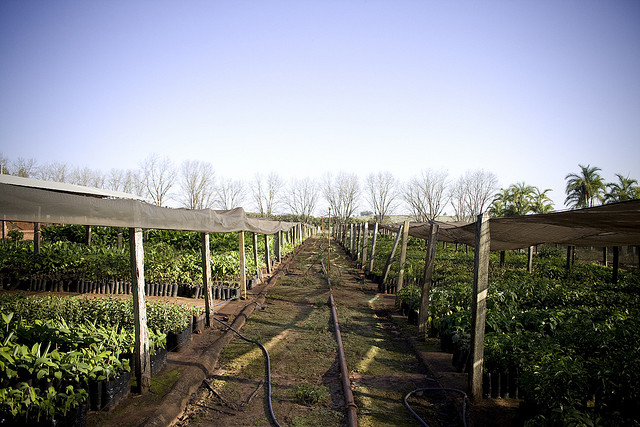The majority of the world’s farmers are suffering. Some are selling off their land to become laborers on their family plots. Some migrate to cities or overseas.
Could a successful movement in Brazil be tried elsewhere?
In 1970, 90 percent of Brazilian farms were smaller than 100 hectares, while only 0.7 percent were larger than 1,000. But by 1996 corporations took over with their monocrop of soy. By 2002 there were 5 million landless families, with 150,000 camped by the roadside.[1]
But then rural communities that had been suffering silently began forging a new, different food system that was not oriented toward a cash crop.
Suddenly, The Brazilian Landless Rural Workers Movement was born and grew to over one million, organizing to occupy disused land.
The Landless Rural Workers Movement began a new, almost entirely organic way of farming, called agro-ecology, and in doing so created a new form of community and self-government.
Their beginnings were humble.
First they formed “encampamentos,” characterized by limited water and food and poor quality shelter. Limited health services and education facilities were provided by the settlers themselves. Success did not arrive overnight. Some families spent several years in these encampments, waiting for land.
Once they found disused land, however, they built settlements of two-bedroom houses close together. The basic organizing unit was the “nucleos” made up of 36 families. Each had a man and a woman coordinator, plus representatives to the sectors of production, environment, health, security, political formation, environment, security, political formation, and—last but not least—education. Shared responsibilities ensured that everyone had a task that benefited the settlement, while awakening self-education and responsibility in each individual.
With a focus on women’s rights to self-representation, there has been a social transformation from “machisimo” to equality of the sexes.
Lessons emerge not only about organic farming, but also about civil and social engagement. To this day, the environment continues to matter a great deal. Each settlement has a tractor and a range of crops grown almost entirely without pesticides. Finding water and growing food together remains an integral part of life—but equally important is providing the space for members to think for themselves, discuss democratically and own their own mistakes.
Participation is voluntary and people are free to leave at any time.
Initially these organic cooperatives had trouble when they tried to sell their produce. Supermarkets want standardized and bar-coded products. Because supermarkets globally control most of the food market in each country, little clout is left for small, rural, organic cooperatives to press their needs. Thus, supermarkets indirectly created poverty for these small local farms and farmers.
But the settlement fields were lush with organic maize, beans, sugar cane, bananas and all kinds of vegetables—everything but soy. Slowly, each cooperative farm turned a profit with its existing crops—with fresher food, better working conditions and revenue shared equally among the farmers.
Currently The Landless Rural Workers Movement has developed its own university with support from Cuban and Venezuelan governments. The University functions as a research and training station in advanced agro-ecology open to anyone, but also as a training center for those from the Movement who want to learn. The first students walked through the University doors in 2006.
Could this movement be a model for other Latin American countries? I do not know. The corporate giants in the food system are rich and powerful and do not always play by the rules. But this Brazilian experiment seems to be an inspiration for what is possible.[2]
~
[2] Most of the facts on the Brazilian Landless Rural Workers Movement come from Raj Patel’s “Stuffed and Starved.”
~
Relephant:
Overcoming Global and Local Food Insecurity.
~
Author: Linda Lewis
Editor: Toby Israel
Photo: Scott Ogle/Flickr // Tambako The Jaguar/Flickr
 Share on bsky
Share on bsky






Read 5 comments and reply